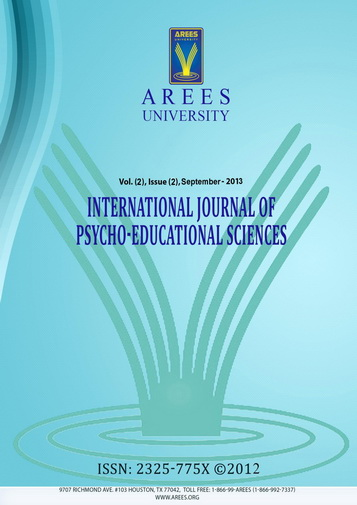Examining the Learning Styles of Prospective Classroom Teachers
Keywords:
Learning, Learning Styles, Kolb’s Learning StylesAbstract
The aim of this study is to determine the dominant learning styles among Kolb’s Learning Styles that are preferred by prospective teachers of Classroom Teaching at the Faculty of Education in Atatürk University and to examine the differences among gender and class levels. The Survey model was used in the research. A total of 93 prospective teachers, who were registered to the Department of Classroom Teaching in the 2011-2012 academic year, participated in the study. Kolb’s Learning Style Inventory (LSI), which was translated into Turkish by Aşkar and Akkoyunlu (1993), was used as the data collection tool in the research. Frequency, percentage values and Chi-Square Independence Test Techniques were used in analyzing the data. According to the obtained data, it was found that most frequently the prospective classroom teachers had an “assimilating” learning style, whereas the “accommodating” learning style was the least frequent. In view of the research, no significant difference was observed among the learning styles and constituents of prospective classroom teachers in terms of gender and class levels.Downloads
References
Akkoyunlu, B. (1995). The Use of Information Technologies in Schools and the Role of Teachers, Hacettepe University, Journal of the Faculty of Education, 11, p. 105-109.
Ames, P.C. (2003) Gender and Learning Style Interactions in Students in Students’ Computer Attitudes. Journal Educational Computing Research. 28(3), 231-244
Arslan, B. and Babadoğan, C. (2005). The Relationship of the Learning Styles of 7th Grade and 8th Grade Students with Academic Success Level, Gender and Age, Journal of Educational Research, 21,35-48.
Aşkar, P. and Akkoyunlu, B. (1993). “Kolb’s Learning Style Inventory”, Education and Science, 87, 37-47.
Babadoğan, C. (2000). Developing Course Design Based on Learning Style, Journal of National Education, (147), p. 61-63
Bahar H.H., Özen Y. and Gülaçtı, F. (2007). Examining the Academic Success and Learning Styles of the Students of the Faculty of Education in Terms of Gender and Registered Program, 16th National Educational Sciences Convention, Tokat
Çelik, F. and Şahin, H. (2011). Examining the Learning Styles of Prospective Physical Education and Sports Teachers in Terms of Gender and Class Levels (Sample of Mehmet Akif Ersoy University). Journal of Buca Faculty of Education, (31), 23-38.
Demir, M.K. (2006). Learning Styles and Social Sciences Education of Prospective Classroom Teachers. Journal of Educational Research, Spring, Issue: 23
Erden, M. and Altun, S. (2006). Learning Styles. İstanbul: Morpa Kültür Yayınları Ltd.Ş.
Ergür, D. O. (1998). Comparison of the Learning Styles of Students and Academicians at a Four-Year Undergraduate Program in Hacettepe University. Published Doctoral Thesis, Hacettepe University, Journal of Social Sciences, Department of Educational Sciences, Ankara.
Felder, R. M. (1996). “Matters of Style. ASEE Prism”, 6(4), 18-23. http://www4.ncsu.edu/unity/lockers/users/f/felder/public/Papers/LS-Prism.htm (20.10.2009)
Galloway V. & Labarca, A. (1990). From Student to Learner: Style, Process and Strategy. In D. Birckbicher (Ed). New Perspectives and New Directions in Foreign Language Education (pp. 111-158) Lincolnwood, II; National Textbook Company
Guild, P.B & Garger, S. (1991). Marching to Different Drummers. USA: ASCD
Güzel, A. (2004). Examining the Learning Styles and Problem-Solving Skills of the Students of Marmara University. Published Postgraduate Thesis, Marmara University, Institute of Educational Sciences, Department of Educational Sciences, İstanbul.
Jonassen, D.H. and Grabowski, B.L. (1993). Handbook of Individual Differences Learning and Instruction, New Jersey, Lawrence Erlbaum Associates.
Kaf Hasırcı, Ö. (2006). Learning Styles of the Students of the Department of Classroom Teaching: Sample of Çukurova University. Theory and Application in Education; 2 (1): 15-25.
Kalaycı, Ş. (2006). SPSS Applied Multivariate Statistical Techniques, Asil Yayın
Dağıtım, 2nd Edition, Ankara
Karasar, N. (2006). Scientific Research Methods, Nobel Yayınları, Ankara.
Kolb, D. A. (1984). Experiential Learning: Experience as the Source of Learning and Development (pp. 77-78), New Jersey: Prentice-Hall.
Kolb, D. A. (1985). Learning Style Inventory: Self Scoring Inventory and Interpretation Booklet, Boston: McBer and Company.
Kolb, D.A., Boyatzis, R.E. & Mainemelis, C. (1999). Experiential Learning Theory: Previous Research and New Directions. http://learningfromexperience.com/
Mutlu, M. (2008). Learning Styles of the Students of Faculty of Education. Atatürk University, Journal of Kazım Karabekir Faculty of Education, 17, 1-21
Numanoğlu, G. and Şen, B. (2006). Learning Styles of the Students of the Department of Computer and Instructional Technologies. 16th Educational Sciences Convention. Muğla
Okur, M., Bahar, H.H, Akgün L. and Bekdemir M. (2011). “Learning Styles, Constant Anxiety and Academic Success of the Students of the Department of Mathematics”, Turkish Journal of Social Research”, 15 (3), 123-134.
Rayner, S., and Riding, R. (1997). “Towards a Categorisation of Cognitive Styles and Learning Styles”, Educational Psychology, 17 (1-2), 5-27.
Saban, A. (2001), Theory of Multiple Intelligences and Education, Ankara: Nobel Yayın Dağıtım.
Uzuntiryaki, E., Bilgin, İ. and Geban, Ö. (2004). Examining the Relationship Between the Learning Styles and Genders of Prospective Elementary School Teachers. Hacettepe University, Journal of Faculty of Education, 26, 182-187.
Yenice N. Saracaloğlu A.S. (2009). The Relationship Between the Learning Styles and Science Success of Prospective Classroom Teachers, Yüzüncü Yıl University, Journal of Faculty of Education, V1 (I), 162-173.
Additional Files
Published
How to Cite
Issue
Section
License

This work is licensed under a Creative Commons Attribution-NonCommercial-NoDerivatives 4.0 International License.










